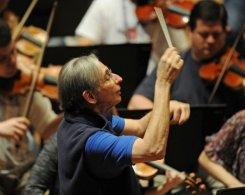YouTube Orchestra's Must-Watch Finale
One of the most varied and fascinating classical music programs anywhere, the entire 2½-hour concert by 101 young artists from 33 countries, playing under the direction of Michael Tilson Thomas in the Sydney Opera House, is available online.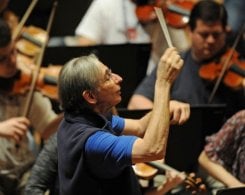
It is all well worth watching, both the performances and the colorful vignettes about participating artists, but here's help for selected viewing: This is the program, with the approximate time when each piece begins. Point at the little round icon on the bottom of the screen and you will see where you are in the program: You can drag it forward or backward.
Berlioz, Roman Carnival Overture (3:00); Percy Grainger, Arrival Platform Humlet (18:00); Bach, Toccata in F Major (22:00); Ginastera, "Danza del Trigo" and "Danza final" from Estancia — conducted by Ilych Rivas, who is just turning 18, younger than his fellow Venezuelan Gustavo Dudamel, (32:00); Mozart canon "Caro bell'idol mio" with Renée Fleming (42:00).
Britten-Purcell, Young Person's Guide to the Orchestra (48:00); didgeridoo piece (1:08:00); Mason Bates, Mothership (1:24:00); Mendelssohn Violin Concerto, last movement, with Stefan Jackiw, Rivas conducting (1:37:00); Abbas-Jacobsen, Ascending Bird, with Kseniya Simonova's sand paintings (1:48:00); Stravinsky, The Firebird excerpts (1:58:00); Schubert, Rosamunde excerpts (2:14:00).
Another Youth Sensation: Conservatory's Dialogues
François Poulenc's 1957 Dialogues of the Carmelites is a magnificent opera, from the first resonant chords to scene after scene, to the hair-raising Salve Regina finale.
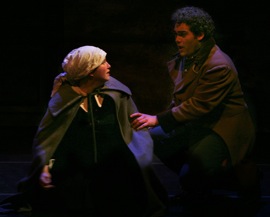
It is also a demanding work to hear, and even more difficult to produce — that's why performances are relatively rare. It took daring, talent, and hard work for the San Francisco Conservatory of Music to offer four performances in four days, and the over-all result deserves a big "Bravi!"
With Michael Morgan conducting, the student orchestra performed sensationally. Poulenc's leitmotif-laden score is sweeping and beautiful, but in lesser hands it can turn saccharine. Morgan and the student orchestra stayed on top of that narrow line, and did so superbly, especially at the first performance.
By Sunday, at the fourth performance in four days, and with a short break between Saturday night and the Sunday matinee, some fatigue had crept into the playing — but then musicians (most of them) are only human.
During the Thursday performance, the orchestra sounded as in the hallowed days of playing Harmonielehre with John Adams on the podium, or Wagner with Simon Rattle in a master class never to be forgotten. Big, very big.
The violins, led by Concertmaster Noémy Gagnon-Lafrenais, violas (Addi Liu), and the cellos (Severin Suter) were major-league. Woodwinds and brass were right along. String section leaders excelled in solos, as well.
Jacqueline Marshall's harp and Darryl Cooper's piano and celeste were outstanding. I’m not sure if the percussion (Jon Lou and Kevin Schlossman) was responsible for this, but for the first time I heard in Poulenc's alarm bells the approaching madness of Boris Godunov — a strange association.
The cast was already discussed in this column before, but, naturally enough, watching performances always brings up something unexpected: the beauty of live shows.
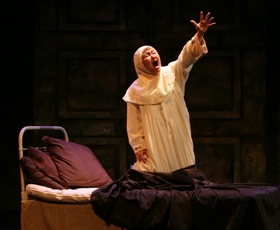
There was, for example, double drama over the pivotal role of Madame de Croissy, the Old Prioress. This role, with its stunning death scene (sung by such greats as Regina Resnik and Régine Crespin in San Francisco), was cast with Kristen Choi Thursday and Saturday, Evgenia Chaverdova Friday and Sunday.
Choi did a great job on first night, then when Chaverdova had to withdraw from the Sunday matinee because of illness (it would have been her last Conservatory role after such memorable appearances as Climene, Public Opinion, Sesto, and Mother Goose) Choi sang the death scene three times in four days. On Sunday, she was at her best, in stunning form, with one of the most powerful performances I have heard in the role.
Choi, Julie Metzler's Blanche, Kate Allen's Mother Marie, and all the men — who have small roles only — handled diction well, otherwise the English subtitles of the English text would have been helpful if only the supertitles didn't try to squeeze so much into the narrow strip over the stage. The purpose of supertitles is to give a general idea of the text, as briefly as possible, not to be a word-for-word representation.
Richard Harrell's stage direction on Peter Crompton's simple but effective sets was fine during the opera, but a bit excessive in changing scenes. At one point, the chapel is transformed into the chapter room, when the same setting would have been just fine. But those are small quibbles; the big picture was laudable. Dialogues of the Carmelites is a daunting challenge, well met in Cowell Theater.
And, thanks to a question from faithful reader Elza Tranter, here's the skinny on where the sound of the guillotine comes from. According to Michael Morgan, whose conductorial duties include assigning the guillotine-playing:
There is literally no tradition. It's trial and error. Rick Harrell consulted with opera directors around the country and settled on equipment he purchased at a hardware store. A long metal rod attached to a large inverted plastic bucket, then another piece of metal was slid along the rod, landing with a thud against the bucket. The whole thing was operated by conductor Andrew Whitfield and was on a microphone.The scariest guillotine sound I have ever heard was in Metropolitan Opera broadcasts. San Francisco Opera used the simplest "instrument" — a paper cutter with the microphone really close.
Music and the Young, No. 3: Gospel for Teens
Lesley Stahl's 60 Minutes segment on Gospel for Teens in Harlem tells about music's power for good, while revealing the act of singing to sometimes be a healing elixir.Watch part 1, part 2, and the touching "overtime."
Music at Kohl: for the Very Young
Music at Kohl Mansion and the San Mateo Public Library are joining again, for the third consecutive year, to provide free concerts for children at the library. The Saturday 3 p.m. series begins April 9, with the Rhythm Sisters, and continues May 7, with the VNote Ensemble.Each event is followed by a postconcert reception to meet the artists. Kohl's famous "Adopt-an-Instrument" program is also available at the library, donating used instruments to children in public schools.
The location is the Oak Room, San Mateo Public Library, 55 W. 3rd Ave., San Mateo.
Young Composers Receive ASCAP Awards
Seven hundred and fifty scores submitted by composers age 10 to 29, and today, the results. ASCAP Foundation President Paul Williams has just announced recipients of the 2011 ASCAP Foundation Morton Gould Young Composer Awards. The awardees will be recognized at the annual ASCAP Concert Music Awards at Merkin Concert Hall in New York on May 24.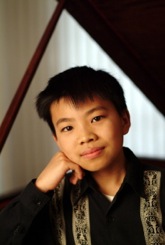
The winners share $45,000 in prizes, along with recognition and performance opportunity. Judges were Derek Bermel, Lisa Bielawa, Steven Burke, Sebastian Currier, Daniel Felsenfeld, Tamar Muskal, and Melinda Wagner.
Morton Gould, a Pulitzer Prize-winning composer, served as president of ASCAP from 1986 to 1994. He was a child prodigy whose first composition was published by G. Schirmer when he was six years old.
Among local and locally-known winners:
- Timothy Andres of Brooklyn, NY (originally from Palo Alto, CA)
- Kit Armstrong of Paris, France (with notable appearances locally from age 10 on)
- Anthony Cheung of Cambridge, MA (from San Francisco)
The following composers received Honorable Mention: Anderson Freeman Alden of New Haven, CT (Los Angeles, CA); Erica J. Ball of Haverton, PA (Bryn Mawr, PA); Francisco Castillo Trigueros of Chicago, IL (Mexico City, Mexico); Louis Chiappetta of Cleveland, OH (White Plains, NY); Paul Dooley Ann Arbor, MI (Santa Rosa, CA); Elizabeth A. Kelly of Los Altos Hills, CA (New York, NY); Elizabeth Anne Nonemaker Los Angeles, CA (Philadelphia, PA); Reinaldo Moya of New York, NY (Caracas, Venezuela); Elizabeth Ogonek of Los Angeles, CA (Anoka, MN); Kate Soper of New York, NY (Ann Arbor, MI); and Dan Visconti of Arlington, VA (LaGrange, IL).
St. Lawrence SQ in Free Good Friday Concert
The St. Lawrence String Quartet gives a free performance of Haydn’s Seven Last Words of Christ on the Cross on Friday, April 22, at 5 p.m. in Stanford University’s Memorial Church. Presented by Stanford Lively Arts in partnership with Music at Stanford and the Office for Religious Life, the work will be interspersed with readings from the Good Friday service by the Rev. Scotty McLennan, dean for religious life at Stanford.The St. Lawrence String Quartet — violinists Geoff Nuttall and Scott St. John, violist Lesley Robertson, and cellist Christopher Costanza — won the Banff International String Quartet Competition and the Young Concert Artists Auditions in 1992, launching a career that has included performances throughout Europe, Asia, and North and South America.
Throughout its more than 20-year history, the quartet has shown a commitment to artistry as well as education. The artists have served on Stanford’s music faculty and as the university’s ensemble in residence since 1998. Beyond the hundred-plus concerts it performs each year, the quartet holds an annual chamber music institute for advanced students and adult amateurs at Stanford and engages in numerous community outreach activities.
San Jose Chamber Orchestra Marks 20th Season
Music Director Barbara Day Turner of the San Jose Chamber Orchestra, who founded the ensemble and directed it for 20 years, is retiring, and she will be the focus of the orchestra's anniversary gala on April 10, in Le Petit Trianon Theater at 72 N. 5th Street in downtown San José. Turner will conduct the concert and play harpsichord solos.The evening's highlights are the commissioned premiere of Emily Wong's Breathin', Walkin', Dancin' for harpsichord, oboe, and strings; the premiere of David Avshalomov's Trotsky's Train for piano and strings; Frank Martin's Petite Symphonie Concertante for harpsichord, harp, piano, and two string orchestras; Craig Bohmler's Concerto for Harp, Strings, and Percussion; and the Adagietto from Mahler's Symphony No. 5.
Participating soloists are Anthony Quartuccio, accordionist/conductor; Gwendolyn Mok, pianist; and Dan Levitan, harpist.
Contemporary Players Celebrate 40 Years, Prepare 41st
San Francisco Contemporary Music Players put on a gala Monday night in Herbst Theatre, celebrating 40 long, difficult, and successful years advocating the classical music of our time. A meaningful part of the festivities: announcing the program for the next season.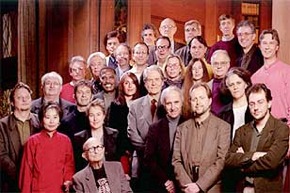
In Herbst, the three founders of SFCMP appeared before the concert, to speak of the inaugural concert on March 25, 1971, and the years since. Jean-Louis LeRoux, Marcella De Cray, and Charles Boone (whose work was performed both at the first concert and on Monday night) all reminisced about "the old organization for young music."
Board President Richard Diebold Lee, also a veteran of all those years, hailed the ensemble that "has become a leader among America's most distinguished and successful chamber organizations," which has commissioned 74 pieces and performed more than 1,150 new works, including 145 world premieres.
The next season, programmed by the new music director, Steven Schick, is titled "Zones of Intensity," a term coined by Edgard Varèse. Highlights include three world premieres commissioned from California-based composers Olly Wilson, Michelle Lou, and Edmund Campion; an hour-long piece by John Luther Adams; and works by Iannis Xenakis, Lou Harrison, John Cage, Salvatore Sciarrino, and others.
In March 2012, Schick will give the 20th anniversary performance of Brian Ferneyhough's percussion solo Bone Alphabet, which was written for Schick and premiered by him in 1992.
9,000 Pieces — China's Secret Piano Factory
The making of pianos is the subject of an exhibit and a lecture series at the Yerba Buena Center for the Arts. Euan Macdonald is at the center of the event, with a YBCA-commissioned work called 9,000 Pieces.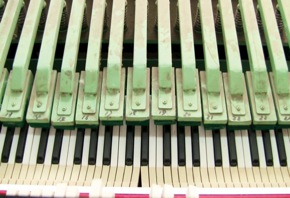
Macdonald's five new multidisciplinary works at YBCA "investigate globalization, perception, and temporality through a single object, the piano." The show’s title video work, 9,000 Pieces, portrays the durability testing of a piano at a secret factory in Shanghai, where instruments are deceptively made for sale as high-end European products.
This single-channel HD video was created in that factory, which produces hand–crafted pianos for Western companies, marketed under some of the top brand names.
During the nine-minute video, the piano's 9,000 parts are tested for a lifetime of use by machines, as a clock records the passing of a single minute. By presenting this scenario to the audience, Macdonald reveals cracks in the reality offered to consumers in today’s globalized society.
Other new works include: Shades, a series of five large graphite drawings of pianos owned by renowned artists, including Elvis Presley and John Lennon, that explore class, historical, and social associations; Kimball, a stop-motion video in which Macdonald uncovers an abandoned antique piano from beneath a pile of discarded books; Out of the Wild, a two-channel video work on the use of two tuning forks; and Play the Piano Drunk, a silkscreen series based on text from Charles Bukowski’s 1979 book, Play the Piano Drunk Like a Percussion Instrument Until the Fingers Begin to Bleed a Bit.
Chris Brown, chair of electronic music at Mills College, will give a lecture on the history of the keyboard at 2 p.m., April 9; Macdonald offers an "alternative artist lecture" on influences in his work, at 6 p.m., April 14. Macdonald's next appearance, from 8 to 11 p.m., April 16, will be about "Piano Conversations and DJ Mixes." All events are held at Yerba Buena Center, 701 Mission St., San Francisco.
Macdonald’s work will be the former San Francisco resident's first Bay Area show since exhibitions at San Francisco Museum of Modern Art and local galleries several years ago. He is best known for video works that play with the power of digital images to undermine widely held notions of truth, using loops and superimposed visuals. He frequently captures everyday, fleeting moments on video and uses that material to challenge viewers’ expectations of seemingly ordinary situations.
The artist also maintains an ongoing interest in music, incorporating such elements as sheet music and instruments in his explorations of illusion.
'Let the Reader Beware'
In her expose of another publication's misguided editorial policy, Lisa Hirsch provides a simple, completely accurate overview:When you read a music review, you hope that you're getting an accurate view of what oneNo responsible writer or editor would set out to publish "overwhelmingly negative reviews" that Bachtracks warns against, but if someone did, it would be in some way similar to the publication's policy of "not writ[ing] up a review of a concert that's a disaster." The intention to be negative or the prevention of negative reviews even when such are justified: two sides of the same coin, both wrong.reviewer heard and saw at a given concert on a particular day. By and large, that is what you can expect, though as we all know, five people can go to a concert and come away with five different opinions of what they just heard. ...
The purpose of a review is to provide a record of what happened at a performance and to evaluate what happened, whether the reviewer heard greatness, horror, or mediocrity. Evaluation is what sets a reviewer or critic apart; a reviewer theoretically has enough knowledge and experience to support the opinions they form about a performance.
A degree of self-censorship is universal and unavoidable. The problem arises when this becomes overt and imposed. To say to a writer not to write a "negative review" crosses the line of the age-old precarious balance.
A comment from Charlie Cockey, who as a film-festival programmer is subject to being reviewed all the time (although, as seen in the next column item, he occasionally wields the pen himself):
It is not just a performance that is on display when an article on it is published; it is the reviewers on display as well: their acumen, their perceptivity, their knowledge, their writing skills and of course their taste — their likes and dislikes.Knowing a reviewer's predilection is as important to the reader in judging the writer as whether the writer praises or pans a work of art, be it a performance of some sort, a film, or a painting. Requiring a writer to avoid writing on poor performances thus jeopardizes the writer even more than either the performer or the reader.
If you don't know what a writer does not like, how can you judge whether their likes are meaningful? Authors are robbed of one of the important weapons in their intellectual arsenal, and the reader is robbed of a full understanding of both the writer's and the performer's capabilities.
Haas Quartet Comes, Plays, Conquers
A report from San Franciscan Charlie Cockey, now a resident of Brno, Czech Republic, visiting our sunny city just to czech up on such musical events here ...
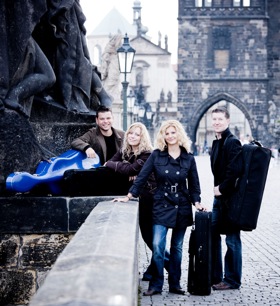
For the daring, the enlightened and the just plain lucky who were there, the Sunday evening San Francisco Performances concert by Prague's Pavel Haas String Quartet in Herbst Theatre was stellar, the sheer joy of experiencing four intensely talented musicians in an exciting program.
The evening began and ended with major yet little-known works by two Czech masters, both victims of Terezin and World War II Nazi death camps, with Debussy's String Quartet in the middle.
Starting with Ervin Schulhoff’s String Quartet No. 1, through the well-known Debussy and ending with Pavel Haas' String Quartet No. 2 ("From the Monkey Mountains"), the foursome played with energy, focus and impeccable ebb-and-flow mini-shapings, details that were full of happy surprises.
Both the Schulhoff and the Haas pieces sing their Czech musical roots boldly and rhythmically. Even when the harmonies get jagged and adventuresome, the driving pulse of the music could pull a reluctant, conservative listener into the dance. The Haas is one of the few pieces I know of that openly shows the influence of the composer's teacher, Leoš Janáček, sections of its first movement wonderfully reminiscent of the driving end of the first movement of Janáček’s String Quartet No. 1.
The group’s anchor seems to be the cellist Peter Jarušek, who must have most of the music committed to memory, so consistently and intently did he keep a close eye on whoever had the lead and cues. The rhythmic élan of the pieces was impossible even for the players to ignore, as they moved — like swimmers or dancers — sometimes rocking this way or that, body English — no, make that body Czech.
They played both like angels and peelers of onions — peeling away revelatory layer after layer of the music to reveal a unified core that could bring tears to your eyes. The encore was the Waltz from Britten's Three Divertimenti. I fervently hope they will be coming back. If you missed them this time, I wouldn’t make the mistake of missing them again.
Another Ferocious, Enigmatic Musical Sperm Whale
Just last week, we were talking about Jake Heggie turning 50. His operas include Moby-Dick. Few people, Self included, have the information uppermost in their minds that Moby has been made into something singable before.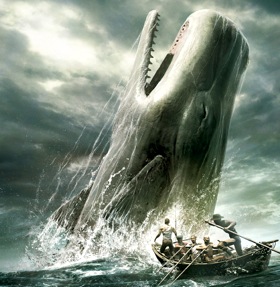
But John Kendall Bailey knows, and he will lead the American Philharmonic–Sonoma County in a free performance of film-score maven Bernard Herrmann's Moby Dick Cantata — a West Coast premiere and the first performance in the U.S. since the 1940 premiere by the New York Philharmonic under John Barbirolli. That's one whale of a time between performances. The event is part of Herrmann's centennial celebrations.
Herrmann, whose famous scores were heard in movie theaters, ranging from the 1941 Citizen Kane to the 1976 Taxi Driver, with Psycho, Vertigo, and dozens of others in between, was also a prodigious composer of opera, chamber music, and the like.
The concerts will take place April 9-10 at the Wells Fargo Center for the Arts in Santa Rosa. The program also features Aaron Copland’s Appalachian Spring, Samuel Barber’s Adagio for Strings, and Leonard Bernstein’s Overture to Candide.
Moby Dick calls for soloists singing the roles of Ahab, Ishmael, Starbuck, Pip, and others; a men’s chorus; and a large orchestra. Herrmann’s interest in unusual instrumentation is apparent in the work, with sections that require three piccolos and three English horns.
The hallmarks of his mature style are already present: ostinatos, two-note motives, a fondness for low woodwind sonorities and muted brass, and an impressive ability to bring out the psychological and dramatic elements of a story and its characters.
Bailey first heard Herrmann's music when he was about 12 and, having spent much of his life and career studying Herrmann’s film scores and concert works, brings special insight and passion to these performances. He will also be conducting Herrmann’s suite from Vertigo with the Oakland East Bay Symphony the weekend following the AP–SC performances, and other Herrmann works later in 2011.
More Moby
This is from the Onion, the parody paper, but it juxtaposes well with the revival of the Bernard Herrmann work. Cover Author Working on Word-for-Word Remake of 'Moby-Dick' is the headline, and the story is that author Gerald Putty says he is about six months away from finishing a word-for-word rewrite of Herman Melville's masterpiece, Moby-Dick, claiming that his version will be "utterly true in every way" to the original."When you cover a novel like this, you're tempted to play with all kinds of things — sentence structure, meter, all the commas," said Putty, adding that fans of the original will be pleased that he retained the same chapter numbers and titles. "I might alter the font a little, but other than that, this book will be a pretty faithful cover." Putty confessed that he has run into a few problems because his spelling is not as good as Melville's, but said he felt no shame falling short of one of the greatest writers of all time.
Fleischmann Memorial Concert in Los Angeles
Classical Voice's Lisa Hirsch reports from the Disney Concert Hall ...
"He was an angel."
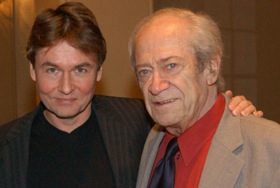
That was Gustavo Dudamel's characterization of Ernest Fleischmann on March 29, at the Los Angeles Philharmonic's celebration of the orchestra's late executive director. I must say that I was surprised; everything I've read, or heard privately, about Fleischmann suggests that, putting it politely, "difficult and complex" would be closer to the mark than "angelic." And indeed, many tributes in the program book and from the stage, affectionate and loving as they often were, alluded to the difficulties.
But Fleischmann was also brilliant, hardworking, and utterly dedicated to music. Without him, we wouldn't have had Carlo Mario Giulini and Esa-Pekka Salonen as music directors of the LAPO, and we wouldn't have Walt Disney Concert Hall, one of the world's greatest halls.
The program, which consisted only of 20th- and 21st-century chamber works, surely would have pleased Fleischmann, who tirelessly championed new music, both at the LAPO and as director of the Ojai Festival. (I'm not sure how he would have felt about the fact that the handsome program book was so strongly focused on him that it omitted the composition dates of the four pieces.)
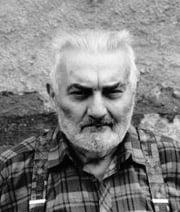
The entire first half of the program was devoted to a spectacular performance of Pierre Boulez' sur Incises, for three pianos, three harps, and three percussionists, led by the composer himself. The next time someone tells you that Boulez' music is unbearable — a view I heartily dispute — put on sur Incises, which won the Grawemeyer Award for Music Composition in 2001. Sure, it's complex, but, more than the complexity, what I took away from this performance was the memory of a magnificent and glowing beauty.
Above all, Boulez is a French composer, and sur Incises, with its richly textured and ever-shifting surfaces, will remind you far more of Debussy and Messiaen (Boulez' teacher) than of "serialism," the compositional technique. It has many startling moments; is he really alluding to a bluesy jazz in the opening? And what about the steel drums, an alien sound wandering in from afar? There's no birdsong, but I heard some gamelan in the chiming, pealing instrumental combinations. Hats off to all of the performers and to Maestro Boulez.
After the intermission, conductor Anne Tomlinson led the Los Angeles Children's Chorus in a beautiful performance of Esa-Pekka Salonen's Donna Nobis Pacem, which received its U.S. premiere. What a tremendous group of singers: pure of tone, accurate of intonation, rhythmically alert and alive, phrasing with great maturity. The work itself is lovely, moving from medieval austerity to a Debussian richness before focusing down at the end to just one pitch. A prayer for peace, indeed; I predict that it will be widely performed by children's choruses everywhere.
Franco Donatoni, one of Salonen's composition teachers, was represented on the program by Arpège, for flute, clarinet, violin, cello, vibraphone, and piano. As its name suggests, it's a commentary and meditation on arpeggios and other running figures. It skittered, it trilled; pairs of instruments played against each other.
The violin played a mad cadenza ... and so on; not an easy work to take in on first hearing. Lionel Bringuier, 24, now in his fourth year as associate conductor of the LAPO and with his own band in Valladolid, Spain, conducted ably.
The program closed with a cheeky and energetic performance of Stravinsky's charming and circuslike Renard, led by Conductor Laureate Esa-Pekka Salonen.

